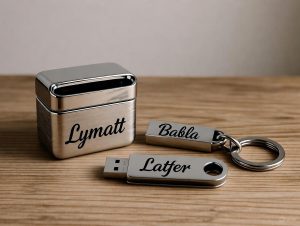 Every personalized gift has a story that begins long before it reaches the shelves or a shopper’s hands. Behind each engraved keychain, custom mug, or laser-cut nameplate lies a complex network of suppliers, processors, and designers who transform raw resources into beautiful, meaningful items. In Europe, this intricate process connects heavy industries like mining and metallurgy with small creative workshops that specialize in custom design. It is a quiet yet fascinating collaboration between technology, craftsmanship, and sustainability.
Every personalized gift has a story that begins long before it reaches the shelves or a shopper’s hands. Behind each engraved keychain, custom mug, or laser-cut nameplate lies a complex network of suppliers, processors, and designers who transform raw resources into beautiful, meaningful items. In Europe, this intricate process connects heavy industries like mining and metallurgy with small creative workshops that specialize in custom design. It is a quiet yet fascinating collaboration between technology, craftsmanship, and sustainability.
The journey of personalization often starts with raw materials sourced from the earth. Metals such as aluminum and brass are extracted from mines across Europe and beyond, while acrylics and plexiglass come from chemical processes that convert petroleum derivatives into clear, durable plastics. These materials later find their way into design studios where artisans and engineers give them a second life. Today, anyone can even order a funny USB stick through AllesMakkelijk (grappige USB stick bestellen), a Dutch-based online retailer known for its practical and creative gift selections. The company offers an array of customizable items that reflect how industrial materials are reshaped into objects of everyday delight.
Mining the Foundation of Design
Raw material extraction may sound far removed from personalized gift-making, but it is the foundation of everything that follows. Aluminum, for example, begins its life as bauxite ore, a reddish clay found in places like Greece and France. Through refining, smelting, and casting, the metal is converted into lightweight sheets that can be molded, engraved, and colored. This versatility makes it ideal for everything from sleek home décor to portable gadgets. Similarly, plexiglass, born out of chemistry labs in the early 20th century, has become a go-to material for modern designers. Its clarity and durability make it perfect for customized items such as photo frames, jewelry boxes, or even glowing name signs.
The Role of Technology in Refinement
Once materials reach the manufacturing stage, technology takes over. Advanced machines like CNC routers and laser cutters allow designers to achieve precise detail, turning simple slabs of metal or acrylic into personalized masterpieces. The introduction of digital design tools has further streamlined this process. Designers can now experiment with 3D rendering software to preview a final product before it’s ever produced. This blend of digital craftsmanship and manual skill allows even small European studios to compete globally, offering high-quality, personalized products with minimal waste.
From Factory to Studio: A Collaborative Chain
Behind every refined design lies a network of collaborations between factories, artisans, and consumers. Factories ensure consistent quality, artisans infuse creativity, and customers add meaning through personalization. A keychain may begin as an anonymous metal blank but ends up carrying someone’s initials or a company logo. This journey highlights how personalization isn’t just an aesthetic choice; it is an emotional connection forged through material and design. When customers choose personalized items, they’re engaging with a product shaped by countless unseen hands across multiple industries.
Sustainability: A Growing Priority
As sustainability becomes central to modern manufacturing, Europe’s custom design sector is evolving fast. Many producers now rely on recycled metals or eco-friendly acrylic alternatives to reduce their carbon footprint. Designers are also emphasizing durability, ensuring that customized products last longer and minimize waste. Initiatives promoting circular design, where old materials are reprocessed into new items, are gaining traction. These changes not only help the environment but also align with a growing consumer desire for responsible craftsmanship.
Turning Raw Resources into Emotional Value
What truly transforms raw materials into refined design is intention. A slab of plexiglass is nothing until it becomes a sentimental desk plaque. A chunk of aluminum gains meaning only when it’s shaped into a name tag or keychain with personal significance. This emotional layer is what keeps Europe’s custom design industry thriving. From luxury kitchenware to small items like USB sticks, the artistry lies in turning industrial resources into symbols of identity and affection.
The Future of Personalized Manufacturing
Emerging trends suggest that personalization will only grow more sophisticated. Artificial intelligence and data-driven customization tools now allow consumers to visualize their products in real time. Imagine selecting materials, shapes, and engravings online and watching them come to life through augmented reality previews. This interactive approach deepens the connection between maker and buyer, continuing the story that started from mined minerals or processed resins.
Conclusion: From Earth to Emotion
The hidden supply chain behind personalized gifts reminds us that creativity is built upon the foundations of industry. From mined aluminum to molded plexiglass, every material carries the effort of countless professionals who shape it into something meaningful. Whether we order a funny USB stick or choose a custom-engraved lamp, we participate in a grand process that turns natural resources into expressions of care, humor, and individuality. That journey, from raw material to refined design, proves that even the smallest gifts can have a big, beautiful story behind them.

